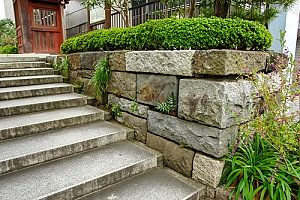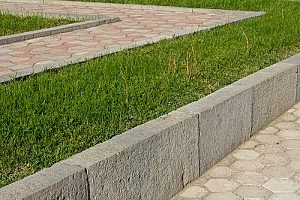 A well-planned, well-constructed retaining wall in your front yard can be gorgeous and functional. Properly designed and landscaped, front yard retaining walls should not look like a fortress wall.
A well-planned, well-constructed retaining wall in your front yard can be gorgeous and functional. Properly designed and landscaped, front yard retaining walls should not look like a fortress wall.
A retaining wall is appropriate in the front yard to control erosion on a slope, edge a driveway or other hardscape, create curb appeal, control the direction of run off, and maximize the use of your yard space. You may need a wall for just one of these reasons or for several of them.
Planning the Front Yard Retaining Walls
Establish your budget. If you plan to do it yourself, you can save money on the labor costs, but make sure you are up to the heavy labor that could be involved in a larger project.
Before you decide to build it yourself, you would be wise to consult with a couple of contractors to get their professional opinions on what the job may entail. For example, you will need to bring in crushed stone and fill dirt to provide a stable support for the front yard retaining walls.
If you have a steep slope, you may need an engineer to plan proper terracing and drainage to achieve effective erosion control. In short, the job of building retaining walls with fill dirt may be bigger than you realize. Get estimates from the contractor – you may decide that you can save yourself time, money, and headaches by having it professionally installed.
Consider the wall’s height. If you decide to build the front yard retaining walls yourself, you will want to keep the wall lower in height. Most local building codes require a permit for anything taller than a few feet. A taller wall creates a serious risk of injury if it were to collapse and requires the help of an engineer and a licensed contractor to construct.
You will want to decide whether the wall will have curves or straight lines. You can use a rope or a garden hose to outline the length and shape of the wall.
 What materials will you use to construct the wall? You can make the job easier on yourself by using blocks and stones manufactured for retaining wall construction. They have grooves and lips that help them fit together securely.
What materials will you use to construct the wall? You can make the job easier on yourself by using blocks and stones manufactured for retaining wall construction. They have grooves and lips that help them fit together securely.
Make sure the color tones will go with your existing structures and hardscapes. If you are going to construct a patio or other hardscape, you will want to incorporate those materials into your design and budget. If you plan to renovate existing hardscapes, how will you dispose of the old materials?
Once you have a plan for your retaining wall project, check with your homeowners association if you have one. You will probably need to get your HOA approval before beginning to install any walls or hardscapes in your front yard. Also, make sure you get necessary permitting from your municipality.
Constructing the Front Yard Retaining Walls
Whether you do it yourself or have a contractor do the job, the steps are the same. Before you begin digging, call Miss Utility to make sure you are not going to dig into existing underground cables or pipes.
- Dig the base for the wall. The base should be slightly wider than the blocks you are using. Dig out the base about six inches below grade. Setting the base stones below ground level will add good support to the wall. If your wall goes across a slope, you should dig a series of stepped trenches so that only one course of blocks is below ground. Compact the base bed until the base is level.
- Dig out the area behind the wall about two feet into the slope. Lay filter fabric at the base and up the side of the slope. Fill the trench with three inches of crushed stone and compact and level it. Then place two inches of stone dust on top of the crushed stone, compact and level it. A level, solid and stable base is extremely important to the integrity of the wall.
- For drainage on slopes, you should add a drainage pipe in the base behind the wall.
- Drive stakes into the ground at the ends of the trench. Stretch a string between the stakes to establish a level line even with the top of the first stone. Use the string as a guide for laying the rest of the first course.
- Start laying the base stones at the edge of the wall that will be most visible, or an edge that will butt up against another structure. If your wall goes across a slope, start at the lowest end. Lay the base blocks on top of the crushed stone base. Use a rubber mallet to hammer them in to the base. Level each block side to side and front to back. As you go double check and level each layer, making sure any tongues/grooves line up properly.
- Begin the next layer and apply adhesive to the corner blocks of each layer.
- Pull the filter fabric up against the back of the wall. Backfill with crushed stone between the fabric and the two foot area you dug out behind the wall as you complete each layer of the wall. Backfilling behind each layer as you build keeps each layer supported. You need to compact the fill to limit settling later.
- At the top of the wall, install the cap stones. First set and glue down the corner cap, allowing the block to extend 1 inch over the wall. Then glue the remaining cap stones to complete the wall top.
- Backfill the wall with crushed stone and compact it well. Cover the stone with the fabric filter. Add six inches of top soil on top of the fabric.

Contact Dirt Connections for Free Fill Delivery
When planning your wall, contact Dirt Connections to discuss the amount and type of fill you will need for your project. The experts at Dirt Connections can give you information about the best material for your front yard retaining walls and schedule a delivery. Call Dirt Connections for more information and to schedule your free fill dirt delivery.









































